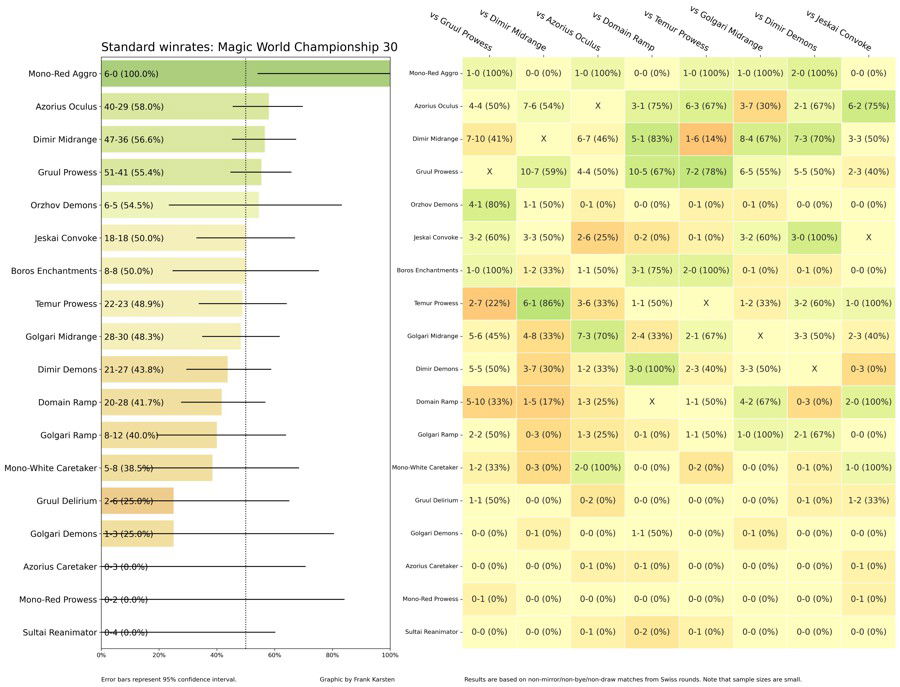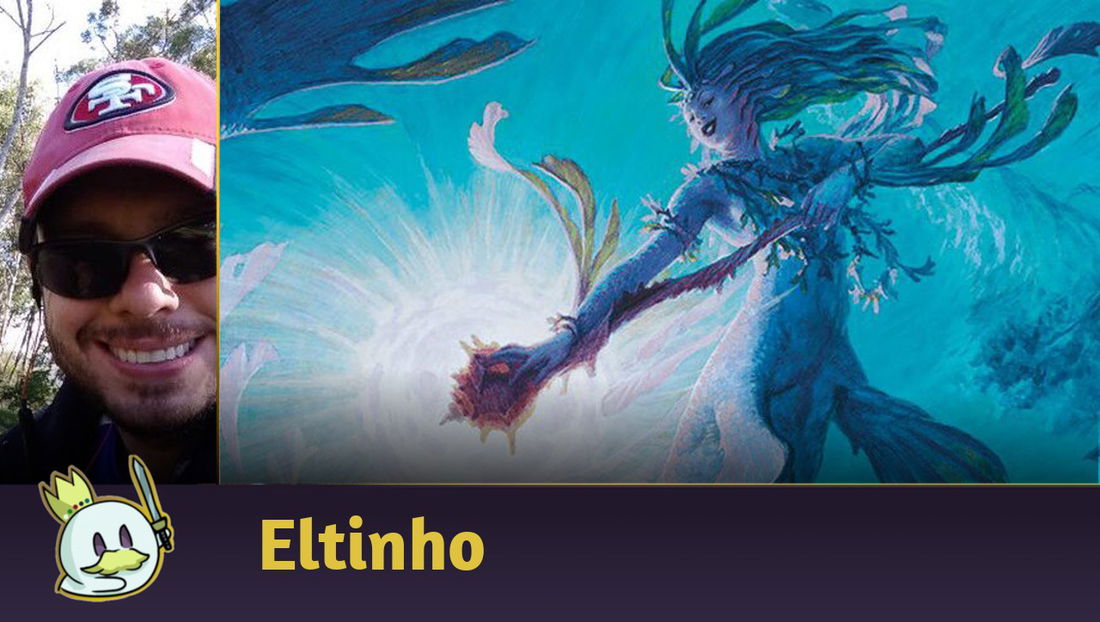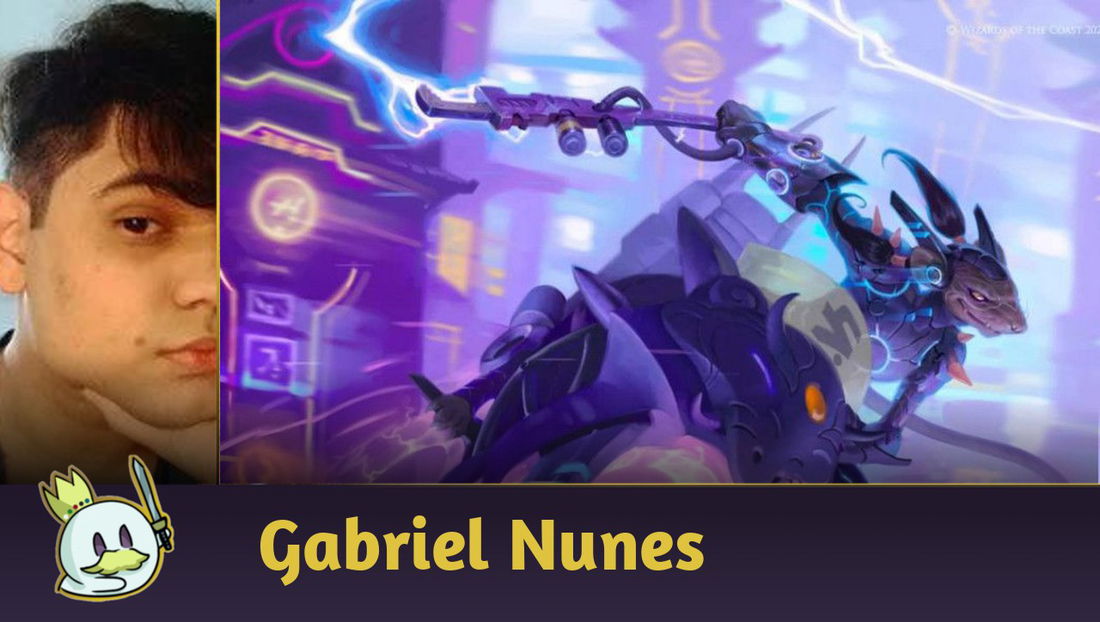The World Championship, despite the small number of competitors, is one of the most influential tournaments in Magic: The Gathering - few things scream "I want to play this deck!" more than "this deck won Worlds!". The winner this time was Javier Dominguez with one of the event's new archetypes, Dimir Demons - but this wasn't the only deck that stood out in the tournament.
In this article, we present eight decks that we can categorize, based on their win rates and matchups, as winners and losers of the 30th World Championship. For this article, we used the winrates shared by mathematician Frank Karsten on Twitter and also the spreadsheet made by one of our writers at Cards Realm, Dereck Duque.
Ad
You can check out Karsten's winrate metrics in the image below.

The Winning Decks of World Championship 30
Gruul Prowess
This is one of the rare occasions where an event's "Target Deck" manages to stay above the expected winrate standards. In Pro Tours and other tournaments in 2024, it was common for the most targeted archetype to be very close to or below 50% winrate, Gruul Prowess maintained an average of 55.4%.
But we can break these numbers down further, as Gruul was split into two categories: the versions with Innkeeper’s Talent were the majority, with 17 decks and a 50.63% winrate, with poor matchups against Demon variants (Dimir, Orzhov) and Azorius Oculus.
The versions with Leyline of Resonance, which represented only three of the 20 lists of the archetype, had the second highest winrate of the tournament with 70%. Given the small sample size, it is difficult to say where its weaknesses or advantages lie, but it is worth mentioning that it lost two matches against Boros Enchantments.
Post-Worlds, it's likely that Leyline versions will become a bit more popular, although we saw the consequences of using it live in the last round of Swiss, where Jean-Emmanuel Depraz drew the enchantment from the top at crucial moments when he needed a pump and/or another creature. However, it's also important to mention that Depraz only didn't make it to the Top 8 because he misread a moment in the match in which he could have gone for the combo-kill and decided to play it safe.
Mono Red Aggro
Mono Red Aggro was the deck with the highest winrate at Worlds, despite having only two copies. With an 85% win rate in Swiss rounds (our spreadsheet considered Mono Red Prowess and Mono Red Aggro to be the same deck), it proves that splashing to green isn't always necessary for better results and puts a huge spotlight on Screaming Nemesis, whose interaction with Witchstalker Frenzy and Burn spells made a difference in preventing some opponents from gaining life.
The amount of interaction and Burn in this variant will draw players' attention in the coming weeks as a potential answer against Prowess and other archetypes. In addition, it's likely that Screaming Nemesis will start to gain ground in non-Leyline of Abundance versions of Gruul Prowess due to its potential to lock down one of the main ways to extend the game against it.
Azorius Oculus
Azorius Oculus had a very satisfactory win rate, with 58%, but was unable to convert these numbers into a Top 8. At some point, its players ran into major Midrange walls (it had 30% wins against Golgari) that prevented the positive results against the other archetypes from standing out and securing a spot for one of its players on day three.

Ad
In the coming weeks, we can say that Founding the Third Path, which not every list was using, will become a staple of Azorius Oculus because it offers a little bit of everything the deck wants. This strategy may also need a more solid plan against Midranges - despite the positive rate against Demons, the sample size is very small - and more ideal answers against Aggro, even with a 62% win rate against versions with Innkeeper's Talent.
I feel that Oculus has become a great option for medium and large tournaments with unknown Metagames. Its overall rate was very positive, both against the best deck in the format (Gruul Prowess) and against lesser-played archetypes. There is work to be done to prevent Midranges from taking all the glory from its player, but it is well positioned today.
Dimir Midrange
Dimir Midrange will solidify itself as the best Midrange in Standard now that it has placed two copies in the Top 8 of Worlds and has proven itself more diverse between its traditional versions or Dimir Demons. Between the two, Midrange had the best overall results with a 54% win rate at the event, with its worst matchup being against an archetype that performed very poorly: Temur Otters.

Kaito, Bane of Nightmares proved his worth in every match where the camera was showing a Dimir Midrange game. His mix of self-protecting threat, win condition, source of card advantage and board interaction make him an extremely versatile Planeswalker.
Jeskai Convoke
Jeskai Convoke is in a relatively similar position to Azorius Oculus, but with less expressive numbers. In fact, the big reason why its 50% winrate is not higher is the presence of Azorius Oculus, against whom it had a 25% winrate.
Its matchups against Midranges were mostly average to good, and it managed to stay above 50% against Gruul Prowess, leaving it in a favorable situation for the next few weeks, but hardly in the position of one of the best decks due to the abundance of hate specified against it available in the format.
The Losing Decks from World Championship 30
Domain Ramp
Between Gruul Prowess as the best deck and Azorius Oculus operating in the Tempo category, in addition to Dimir Demons with combo-kills and Dimir Midrange with better answers than the other categories being rising archetypes, Domain Ramp has a dark future ahead of it. With only 39% Winrate, it stands out against Golgari Midrange and Caretaker’s Talent lists, which, for the most part, also did very poorly.
Temur Otters
Temur Otters came into Worlds as an unknown quantity and will leave it in the same position. In theory, it had a good winrate against Dimir Midrange and Demons while having a horrendous matchup against Gruul Prowess and Golgari Midrange. Its other results point to it being bad against Aggro and good against archetypes that take too long to interact - which is hard to find when Aggro is the deck to beat.
Ad
Caretaker Tokens
The Caretaker’s Talent variants at Worlds together had a total of 41% of Winrate, with 0% against Dimir Midrange or Dimir Demons, two archetypes expected to grow in the coming weeks. It also has a supposedly bad matchup against Temur Otters, but the sample size is low.
I believe Tokens' problem is that it is designed to play on top of Midranges and is extremely vulnerable against the entire counterspell category, making it bad against Phantom Interference and Spell Stutter in a way that even Domain Ramp does not suffer. As long as it is a curve-topper tap-out without access to efficient Ramp, it will continue to suffer at the hands of Tempo plays.
Golgari Ramp
Golgari Ramp suffers from the same problem as Tokens: it is very vulnerable against Tempo plays, and the growth of Dimir Midrange and Azorius Oculus means more games where it is passive and spends turns and turns trying to do something but can't. In comparison, hit had a 40% winrate, 9% less than Golgari Midrange and which kept in the position it was in before Worlds.
The Case of Dimir Demons
Dimir Demons is a difficult deck to evaluate. In numbers, its win rate was 44%, below the ideal to be considered a winner and way below the traditional Midrange versions. However, this was an archetype that was not so much on the format's radar at the beginning of the tournament and managed to take the World Championship in the hands of Javier Dominguez in one of the three distinct variants of the archetype: without combos, with Unstoppable Slasher and Bloodletter of Aclazotz or with Doomsday Excruciator and Jace, the Perfected Mind.

This type of archetype has a lot of growth potential and, in particular, tends to raise a red flag. Combo hybrids have a history in Standard, and they don't end well when an archetype grows too large. Now that Doomsday Excruciator and Jace, the Perfected Mind or Restless Reef are on the radar, players will be refining the list over and over until they eventually land on a version that's too good to ignore.
Once again, it feels like having Aggro as the best deck in the format has never been more important: in a grindfest environment, a “Midrange Combo” like this would already have the potential to take over Standard. But we need to keep an eye on the deck; Excruciator's cost is a major deckbuilding limiter, and versions with Unstoppable Slasher have elements that should be considered in the equation as well.
Perhaps Dimir Midrange will simply be a better version of the category and gain more relevant additions with Foundations, but until then, players need to be ready to deal with Unholy Annex and potential combos coming out of nowhere.
Conclusion
That's all for today!
If you have any questions, feel free to leave a comment!
Thanks for reading!








— Comentarios0
Se el primero en comentar